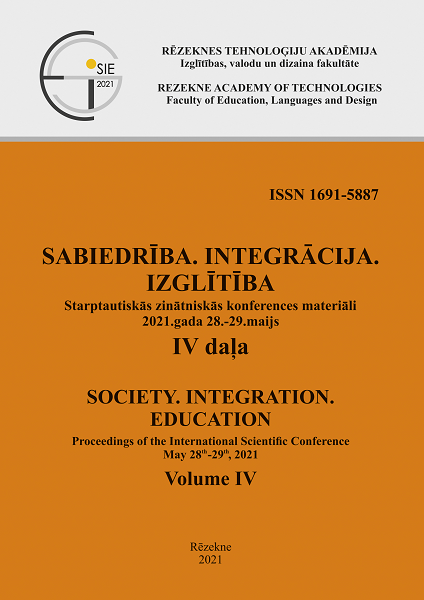THE STYLES OF SPECIAL ARTISTRY IN RHYTHMIC GYMNASTICS
DOI:
https://doi.org/10.17770/sie2021vol4.6303Keywords:
artistry, composition, rhythmic gymnastics, special artistry styleAbstract
Rhythmic gymnastics is a high achievement sport that requires athletes to demonstrate maximal abilities of the human body control while performing imaginative and meaningful compositions. With increasing of the technical complexity of the competitive compositions and striving for high results, less attention is paid to performance aesthetics. But at the same technical level during the competition, a decisive role in the gymnasts' performance is given to aesthetics. Patterns in the choice of composition content and gymnasts’ appearance and emotional similarities during performance allow concluding that there is a certain style, which can be defined as a special artistry style in rhythmic gymnastics. The aim of the research is to develop theoretical model of special artistry in rhythmic gymnastics, setting the tasks to determine, classify, structure, describe with determined artistic criteria and visualize with artistical images the special artistry styles. To develop the model the method of scientific and special literature analysis, audiovisual source analysis and modeling method were used. The model is mainly relying on C.G. Jung's theory of human perception of the world through universal symbols and the primary archetypes of the collective unconscious. Since mainly women participate in rhythmic gymnastics, the determination of the special artistry styles was based on the women archetypes of Ancient Greece goddesses according to the psychoanalyst prof. J.S. Bolen. To illustrate the styles more than 400 audiovisual materials were researched. As a result, the theoretical special artistry 32–style model in rhythmic gymnastics with two matrices of opposite style expressions consisting of 16 images each was created.
References
Boerner, K., & Boyack, K.W., & Milojevich, S., & Morris, S. (2012). An Introduction to Modeling Science: Basic Model Types, Key Definitions, and a General Framework for the Comparison of Process Models. In: Scharnhorst A., Börner K., van den Besselaar P. (eds), Models of Science Dynamics. Understanding Complex Systems. Springer, Berlin, Heidelberg. https://doi.org/10.1007/978-3-642-23068-4_1
Bolen, S.J. (2020). Goddesses in Everywoman. Moskva: Amrita-Rus.
Borisenko, S.I. (2000). Improving the performance skills of gymnasts based on choreographic preparation. St.Petersburg: Lesgaft National State University of Physical Education, Sport and Health.
Carbinatto, M.V., & Reis Furtado, L.N. (2019). Choreographic process in gymnastics for all. Science of Gymnastics Journal, Vol.11 (Issue 3), 343-353.
Gantcheva, G., & Borysova, Y., & Kovalenko N. (2021). Evaluation and development of artistic abilities of 7-8-year-old rhythmic gymnasts. Science of Gymnastics Journal, Vol. 13 (Issue 1), 59-69.
Gorbacheva, Z.S. (2000). Development of plastic expressiveness in rhythmic gymnastics. St.Petersburg: Lesgaft National State University of Physical Education, Sport and Health.
Jungs, K.G. (1996). Psiholoģiskie tipi. Rīga: Zvaigzne ABC.
Karavackaya, N.A. (2002). Development of plastic expressiveness skills in rhythmic gymnastics. Velikie Luki: Velikie Luki Institute of Physical Culture.
Karpenko, L.A., & Savelyeva, L.A., & Rumba, O.G. (2009). Compositional preparation in technical aesthetical kinds of sports. The scientific theory journal «Ucheniye zapiski», № 9 (55), 57-61.
Medvedeva, Y.N. (2017). Objectification of the technical value of the structural group elements of rhythmic gymnastics. St.Petersburg: Lesgaft National State University of Physical Education, Sport and Health.
Medvedeva, Y.N., & Artemyeva, Z.S., & Sakharnova, T.K., & Ilyina N.P. (2020). Ways to improve the plastic expressiveness of competitive programs in rhythmic gymnastics. The scientific theory journal «Ucheniye zapiski», № 8 (186), 180-185. DOI: https://doi.org/10.34835/issn.2308-1961.2020.8
Plyehanova, M.E. (1997). Methods of objectification of the visual assessment of expressive movements in rhythmic gymnastics. Malakhovka: Moscow State Academy of Physical Education.
Pristavkina, M.V. (1984). Performing style as a kind of individual style of activity (based on the materials of rhythmic gymnastics). Leningrad: Lesgaft State Institute of Physical Education.
Shishkovska, M. (2011). Assessment of the components of performing skills in rhythmic gymnastics. St.Petersburg: Lesgaft National State University of Physical Education, Sport and Health.
Spalva, R. (2004). Tēls un dejas kompozīcija. Rīga: Raka.
Terekhina, R.N., & Kryuchek, Y.S., & Medvedeva, Y.N., & Zenovka, I.B. (2014). Modern approach to the process of competitive compositions creation in rhythmic gymnastics. The scientific theory journal «Ucheniye zapiski», № 8 (114), 180-185. DOI: https://doi.org/10.5930/issn.1994-4683.2014.08.114
Vinken, P.M., & Heinen, T. (2020). Perceived aesthetic features differentiating between complex artistic dance skills of varying style. Science of Gymnastics Journal, Vol. 12, (Issue 2), 119-133.






